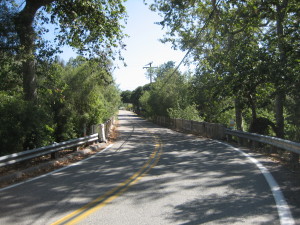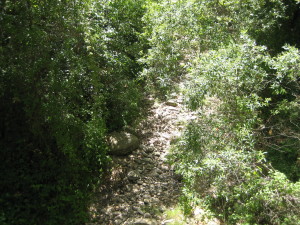One of my favorite spring birding spots is the stone bridge over Rincon Creek. The creek runs along the Santa Barbara/Ventura County line; it’s a thick riparian corridor there, and the best place for observation is from the stone bridge along Bates Road.
Tall sycamores lean right over the bridge. Willows grow in a dense thicket along the creek. The understory is thick with blackberry tangles and honeysuckle vines.
Although this location is good for watching birds in spring migration, it’s best in late spring or early summer as a place to count breeding birds. Nests are often easy to see.
This year, after I had parked and grabbed my binoculars from the car, I wandered over to the bridge. Looking down, I was stunned to see NO water in Rincon Creek. I’ve been birding this location for years (since the 1990s) and this is the first time that Rincon Creek has stopped running in June.
With the water gone, fewer birds are attracted to nest here.
I am pretty depressed, but I know that drought conditions are always reflected in the natural world. And this is how it’s going to be in our region, at least for now.
On the bright side, I saw some nesting activity and juvenile birds. A pair of Pacific-slope Flycatchers is nesting under the bridge. Adult flycatchers were carrying food back and forth, disappearing under the bridge to feed young.
Other evidence of breeding: juvenile American Robins, Phainopepla pair with possible nest location, and a family of Bushtits. Also, a single Swainson’s Thrush sang persistently from the willows.
What really bothered me was comparing the number of species I saw today with that of visits I made in 1998, 1999, and 2000. Today I counted 34 species; visits in 1998 and 1999 totaled 47 and 45 species.
What species are missing?
Let’s discount the pair of Yellow-breasted Chats, which haven’t been seen at Bates Road in several years (I have made more recent visits there, but can’t locate the field notes…..ahem……).
Missing this year are: Olive-sided Flycatcher, Warbling Vireo, Wilson’s and Yellow Warbler.
These are birds that regularly nest in riparian areas, but this year with no water, perhaps they’ve chosen not to breed at Rincon Creek.
In short, the drought will have seasonal effects on nesting birds. If these conditions persist, however, it could result in the birds retracting their ranges so that they simply do not come to this location to breed any longer.
If rains come again this witer, next spring should be back to normal at Rincon Creek. But if they don’t? We may keep losing some breeders on the south coast.



